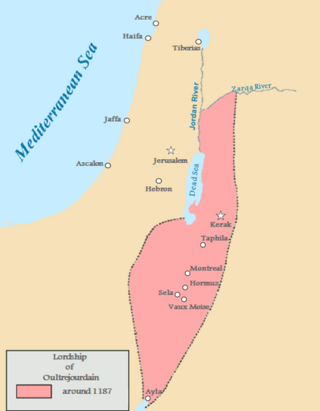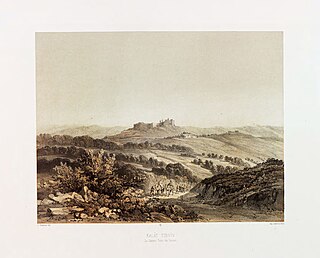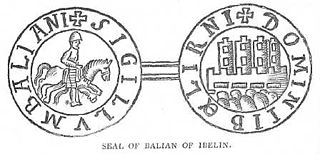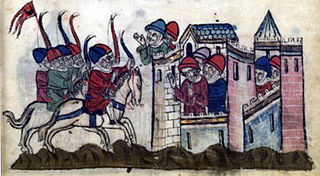
The Kingdom of Jerusalem, also known as the Latin Kingdom of Jerusalem, was a Crusader state that was established in the Levant immediately after the First Crusade. It lasted for almost two hundred years, from the accession of Godfrey of Bouillon in 1099 until the siege of Acre in 1291. Its history is divided into two periods with a brief interruption in its existence, beginning with its collapse after the siege of Jerusalem in 1187 and its restoration after the Third Crusade in 1192.

The Crusader state of the Kingdom of Jerusalem, created in 1099, was divided into a number of smaller seigneuries. According to the 13th-century jurist John of Ibelin, the four highest crown vassals in the kingdom proper were the count of Jaffa and Ascalon, the prince of Galilee, the lord of Sidon, and the lord of Oultrejordain.

There were six major officers of the kingdom of Jerusalem: the constable, the marshal, the seneschal, the chamberlain, the butler and the chancellor. At certain times there were also bailiffs, viscounts and castellans.

The Lordship of Oultrejordain or Oultrejourdain was the name used during the Crusades for an extensive and partly undefined region to the east of the Jordan River, an area known in ancient times as Edom and Moab. It was also referred to as Transjordan.

Toron, now Tibnin or Tebnine in southern Lebanon, was a major Crusader castle, built in the Lebanon mountains on the road from Tyre to Damascus. The castle was the centre of the Lordship of Toron, a seigneury within the Kingdom of Jerusalem, actually a rear-vassalage of the Principality of Galilee.

The House of Ibelin was a noble family in the Crusader Kingdom of Jerusalem in the 12th century. They rose from humble beginnings to become one of the most important families in the kingdom, holding various high offices and with extensive holdings in the Holy Land and Cyprus. The family disappeared after the fall of the Kingdom of Cyprus in the 15th century.

Balian of Ibelin, also known as Barisan the Younger, was a crusader noble of the Kingdom of Jerusalem in the 12th century. He was lord of Ibelin from 1170 to 1193. As the leader of the defense of the city during the siege of Jerusalem in 1187, he surrendered Jerusalem to Saladin on 2 October 1187.
John of Ibelin, called the Old Lord of Beirut, was a powerful crusader noble in the 13th century, one of the best known representatives of the influential Ibelin family. The son of Balian of Ibelin and the dowager queen Maria Comnena, he had close ties with the nobility of both Cyprus and Jerusalem, since he was the half-brother of Queen Isabella I of Jerusalem. Before he was 20, he was appointed constable of Jerusalem, and a few years later became lord of Beirut. John rebuilt Beirut after Saladin's conquest, and established the grand Ibelin family palace. He served as regent of Jerusalem on behalf of his niece Maria of Montferrat from 1205 to 1210 after her mother, Queen Isabella, died. He was also regent for Isabella's grandson Henry I of Cyprus from 1228 until Henry came of age in 1232. John was known as a principled man, and was seen as the natural leader of the Christian barons in the Holy Land. He resisted the power-seeking of Frederick II, Holy Roman Emperor, in Cyprus, and opposed the imperial forces until King Henry came of age.

The double County of Jaffa and Ascalon was one of the four major seigneuries comprising the major Crusader state of the Kingdom of Jerusalem, according to 13th-century commentator John of Ibelin.

The principality of Galilee was one of the four major seigneuries of the crusader Kingdom of Jerusalem, according to 13th-century commentator John of Ibelin, grandson of Balian. The direct holdings of the principality centred around Tiberias, in Galilee proper, but with all its vassals, the lordship covered all Galilee and southern Phoenicia. The independent Lordship of Sidon was located between Galilee's holdings. The principality also had its own vassals: the Lordships of Beirut, Nazareth, and Haifa.
The Lordship of Ramla was one of the Crusader vassal states of the Latin Kingdom of Jerusalem. It has been vassal to and part of the County of Jaffa and Ascalon.
Eustace I Granier, also known as Eustace Grenier or Eustace Garnier, called in Latin Eustachius Granarius in the charters, was a Flemish crusader who took part in the First Crusade. He became lord of Caesarea in 1101 and lord of Sidon in 1110. On 18 April 1123, he was elected constable and bailiff of Jerusalem during the captivity of Baldwin II of Jerusalem. Shortly before his death, he defeated a Fatimid army at the Battle of Yibneh near Ibelin.
Eustace Grenier is quoted in a text in verse written during his life in honour of the knights of the diocese of Thérouanne who accompanied Baldwin of Boulogne to the Holy Land.
Contemporary authors and historians identify Eustace Grenier as a nobleman from the diocese of Thérouanne in the County of Saint-Pol. Alan V. Murray, historian of the Crusades, writes: "However, his origins can be established with a high degree of certainty. The Versus de viris illustribus diocesis Tarvanensis qui in sacra fuere expeditione identifies him as a Fleming from the diocese of Therouanne".

Reginald Grenier was Count of Sidon and an important noble in the late-12th century Kingdom of Jerusalem.
Balian I Grenier was the Count of Sidon and one of the most important lords of the Kingdom of Jerusalem from 1202 to 1241. He succeeded his father Renaud. His mother was Helvis, a daughter of Balian of Ibelin. He was a powerful and important representative of the native aristocracy during the three Levantine crusades of the first half of the thirteenth century.

Julian Grenier was the Count of Sidon from 1239 to 1260, then becoming merely titular. He was the son and successor of Balian Grenier and Ida of Reynel. He did not exhibit the wisdom of his father in his dealings with the Saracens.

The Embriaco were a prominent Genoese family, who played an important role in the history of the Crusader states. It also gave consuls, admirals and ambassadors to the Republic of Genoa.
The Crusade of 1197, also known as the Crusade of Henry VI or the German Crusade, was a crusade launched by the Hohenstaufen emperor Henry VI in response to the aborted attempt of his father, Emperor Frederick I, during the Third Crusade in 1189–90. Thus the military campaign is also known as the "Emperor's Crusade".
Walter II Grenier was the Lord of Caesarea, succeeding his older brother, Guy, between 1176 and 1182. The date of his birth is unknown. His parents, Hugh Grenier and Isabelle Goman, are recorded as husband and wife in five charters between 1160 and 1166.
The House of Granier was a prominent noble family during the Crusades founded at the beginning of the 12th century by Eustachius Granarius, a Flemish nobleman from the Diocese of Thérouanne in the County of Saint-Pol who became lord of Sidon and Caesarea near 1110.
William of Botron was Lord of Botron (1244–1262) in the County of Tripoli, and Constable of Jerusalem (1258–1262).










